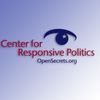Trump's dark money fortunes turned around in October, when 45Committee, linked to Cubs owner Todd Rickets, right, dropped more than $20 million on ads against Clinton and for him. (AP Photo/Charles Rex Arbogast)
By: ROBERT MAGUIRE
Setting a new record and driving much of the higher cost of this year's elections over 2012's, outside groups that weren't formally connected to either political party broke $1.4 billion in outlays in the 2016 cycle. That's up from the $1 billion these groups -- mostly super PACs and 501(c) organizations -- spent in 2012, and way up from the $338 million spent in 2008.
Dark money groups spent almost $181 million in 2016, down from their record of more than $308 million in 2012. That was largely because of a lack of enthusiasm these organizations seemed to have about the presidential race. Down-ballot races, and the Senate in particular, saw considerable dark spending, and a lot of a success.
On the whole, conservative groups -- which have dominated outside spending in past elections by a large margin -- only made up 54 percent of that total, down from 69 percent in 2012. Liberal and progressive groups, on the other hand, boosted their portion of the spending from 28 percent in 2012 to nearly 36 percent in 2016.
Much of the activity, worth $749 million, was focused on the presidential race; single-candidate groups -- those created to support a specific candidate -- made up more than half that spending, $424 million.
Hillary Clinton was the primary beneficiary. The pro-Clinton super PAC Priorities USA Action spent $132 million, more than any other outside group in any race in 2016. That's triple the $43.5 million combined spending of the two largest pro-Trump super PACs, Great America PAC and Rebuilding America Now.
No candidate saw more fusillades aimed at him -- or her -- by outside groups than Donald Trump. Liberal and conservative groups spent almost $248 million attacking him in the primaries and the general election. Hillary Clinton was the target of less than half that much negative spending. However, Trump also received support from outside groups at a higher rate than did Clinton -- $100 million, compared to her $59.2 million.
While Clinton's outside spending advantage wasn't enough to save her campaign, it was a different story further down the ballot. Outside groups flooded Senate and House races with a record $595 million in outlays, nearly three-fourths of which targeted Senate races where the GOP was fighting to maintain its fragile majority. In the end, with conservative groups making up 56 percent of the reported spending, the Republican party kept its majority.
Going dark
Dark money groups spent almost $181 million in 2016, down from its record of more than $308 million in 2012. While there have been some shifts in activity, and some prominent liberal groups have arisen, dark money overwhelmingly remains a vehicle preferred by pro-GOP operatives. Conservative dark money makes up 76 percent of all reported spending, and nearly all unreported "issue ad" spending.
The Chamber of Commerce and the National Rifle Assn topped the list of dark money group spending that was reported to the FEC. The Chamber spent almost $30 million on congressional races, with the greatest portion going to five tight Senate races. In four of those races, the Chamber was on the winning side.
The NRA spent heavily in races up and down the ballot, also with great success. The gun rights group not only went in big for Trump, but also spent heavily against Democratic Senate candidates in North Carolina, Missouri, and Indiana, all of whom were defeated.
In addition to the spending that was reported to the FEC, there was what came before: Many of these groups (mainly "social welfare" groups and other politically active 501(c) nonprofits) invested in months' worth of ads as well as sustained ground support before the date in early September when they would have to begin reporting those expenditures to the FEC. The groups -- like the Karl Rove-linked One Nation and the Koch network's Americans for Prosperity -- don't have to report their wealthy individual and corporate donors to the public, prompting the term "dark money."
The Democrats had their dark money allies as well, but they spent far less than their Republican counterparts, accounting for just 17 percent of reported spending by these groups. They did, however, have some victories. For example, VoteVets -- a liberal dark money group that focuses on veterans issues -- started spending early in support of Rep. Tammy Duckworth's (D) successful Senate bid in Illinois.
While dark money may have had some clearer successes in shaping the makeup of the next Senate class, it was still a big player in 2016 presidential races. Marco Rubio (R-Fla) was bolstered early on by more than $8 million in ads by a dark money group called Conservative Solutions Project, which served essentially as a nondisclosing ally of his campaign; it raised nearly all its money from one anonymous donor. And the American Future Fund, which has become something of a nonprofit-for-hire, became a vehicle for millions in anti-Trump spending when Republicans started to get spooked by the momentum the real estate mogul was gaining in early primary states.
But Trump's dark money fortunes turned around in October, when a social welfare organization called the 45Committee -- linked to Cubs owner Todd Ricketts -- dropped more than $20 million on ads against Clinton and for him.
